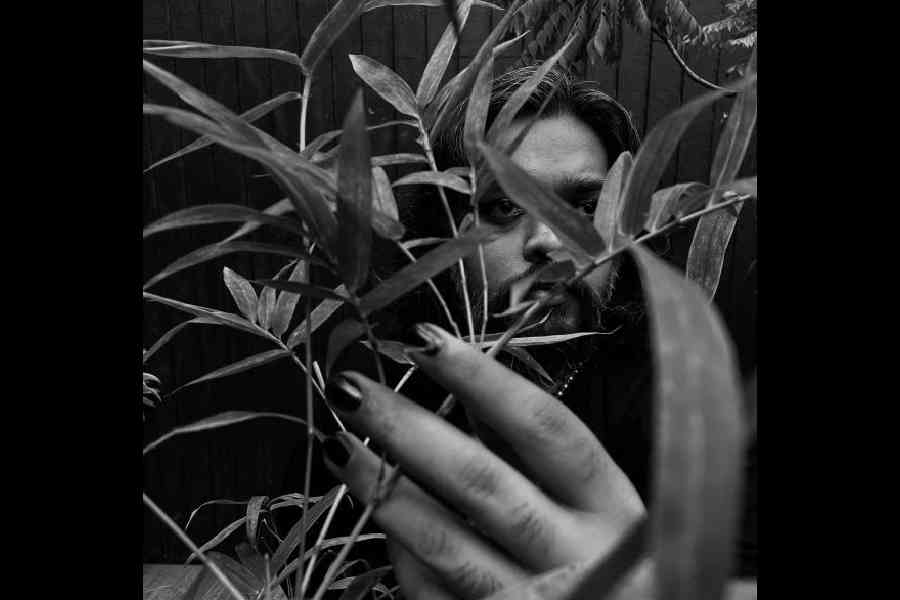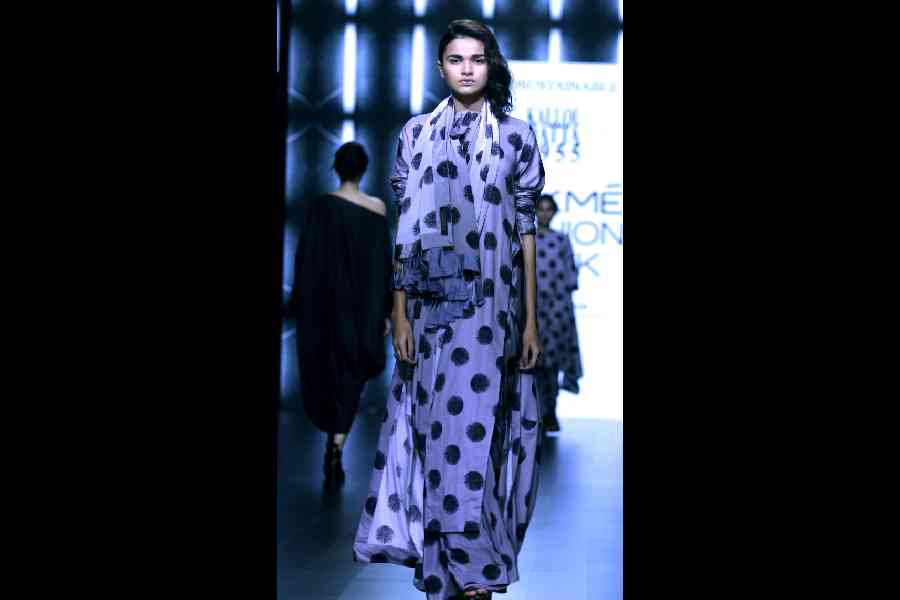He has always been an outsider in fashion. Kallol Datta. Starting off with mainstream fashion in 2008 and very soon stirring up conversations about his offbeat aesthetics with a dark edge, the Calcutta boy became a darling of fashion critics in no time. Mainstream, commercial fashion, however, was not Kallol’s calling. His clothes, from the very beginning, blurred the lines between art and fashion. Shapes were always more crucial to Kallol’s work than trends. Displaying his collections at museums and galleries enticed him more than showcasing them on runways. He started to straddle both worlds — art and fashion — soon, and after 10 years of launching his eponymous label, Kallol Datta 1955, he crossed over to the art side in 2018, but essentially as a “clothesmaker” at heart.
A regular in the experimental art scene in the country, in the past two years Kallol has been showcasing his work at multiple prestigious international venues and events too. His work was a part of an exhibition — Jameel Prize: Poetry to Politics — at the Victoria & Albert Museum in London in 2021. From Japan to Scotland, Kallol’s work has found space in many other galleries across the world.
Kallol’s latest project sees him showcasing his work at the prestigious State of Fashion Biennale at Arnhem in the Netherlands. Kallol is one of the three designers chosen to be a part of the State of Fashion 2024, Ties that Bind project that brings together creative practices in fashion, textiles and contemporary art from across the Global South. The Biennale collection, after being showcased in Sao Paolo, Nairobi and Bengaluru, is now being displayed in its home city of Arnhem in the Netherlands, from May 17 to June 30. Kallol’s chosen region of work for the Biennale was Bengaluru and the collection works with the issue of the water crisis in the city and its impact on clothing. Kallol has always dealt with the politics of clothing and this collection is no different.
In a t2oS chat, Kallol lets us in on the details of the Biennale collection and its curatorial process, and also tells us why clothing will always be political to him.
It’s a huge honour to be invited to be a part of the State of Fashion Biennale 2024. Tell us how it came about…
The co-curators of the Biennale, Rachel Dedman and Louise Bennetts, at the very onset decided on a decentralised Biennale structure and extended an invitation to me to join their curatorial team, to develop and curate a project of my own. It was an absolute no-brainer to accept their invitation, which sought to bring together creative works in fashion, textiles and contemporary art from across the Global South. The project I chose to build and present emerged from my existing studio practice, which is rooted in the research of clothing practices.
Please tell us a bit about the Biennale and how and when it is being showcased…
The State of Fashion 2024, Ties that Bind has four sites. Three sister sites — Sao Paulo, Brazil; Nairobi, Kenya; Bengaluru, India; and the home site at Arnhem, The Netherlands. The Biennale’s home site at Arnhem opened on May 17 at the Rembrandt theatre and will feature the sister site projects as well.
For the Ties that Bind project, you’re working with the clothing practices in Bengaluru. Were you assigned this site or you chose it yourself?
The curators for the sister sites of the Biennale are Sunny Dolat in Nairobi and Hanayra Negrerios in Sao Paulo. I curated the site in India and Bengaluru was the city of my choosing.
The city has been facing an acute water crisis, which impacts its residents’ clothing habits directly. Coupled with the cyclical rise of hyper-nationalism in the region as a reaction to the perceived Hindi imposition from Northern India, clothing too has come under the scanner as evidenced by the 2022 hijab ban by educational institutions in Karnataka, which was upheld by the Karnataka High Court. It was only recently rescinded in December 2023 but across various markers clothing is inherently political.
What kind of research did you have to do into the clothing practices and culture of Bengaluru? How did you approach the curatorial process?

Kallol Datta Picture: Rahul Dhankani
Rather than having an exhibition in mind as the end goal, I had ‘…of involution, of languor…’ foreground care as a connective thread and curatorial principle. The entire project was embedded in community and at the same time un-tethered. In the selection of the artists I invited to be part of the Bengaluru site, I was looking at those artists whose practices were involved in long-term inquiries into care, sustaining engagements with community and radical ways of knowledge sharing, who also had a working relationship with textiles to create secure spaces, however intimate the spaces may be.
You’ve always presented garments as a conduit for personal agency and expression. How has that happened in this project?
‘…of involution, of languor…’ is positioned as a proposition against a landscape where the body, the cloth and the act of swaddling oneself are political. The artists that I collaborated with — Indu Antony, Rujuta Rao and Swati Kalsi — highlight care at the forefront of their artistic and research projects for the Biennale sister site.
In a country where water is deified, seen as a conduit to spiritual cleanliness, as a means to attaining purity, Indu Antony and the women of Namma Katte (a part of Mindscapes Bengaluru, a mental health programme run by the Museum of Art & Photography) address the scarcity of water by repurposing used clothing to highlight varying structural inequalities in their everyday lives.
Rujuta Rao spotlights complex human conditions by macerating textile and non-textile belongings of people who bring her comfort, thereby creating systems of self-care.
Textile designer Swati Kalsi’s creative research project is a long-term inquiry about the potential in forming a radical system of knowledge sharing between her and the craftspeople and artisan groups she works with, thereby formulating channels of care through assistance in technology, skill updates and design research.
Filmmaker Rusha Bose made a short on the women of Namma Katte — a leisure space created by Indu Antony in the Banaswadi neighbourhood in Bengaluru and architect Aniket Kumar Rathore designed the exhibition space at 1 Shanthi Road.
The Ties that Bind project explores the political potential of clothing. What do you feel about that?
I’ve had folks ask why is there a need for a biennale on fashion and questions on similar lines. But in times where what you wear makes you an immediate marker of your community, where donning a pair of jeans could mean losing your life to violence, where people occupying the highest political offices in the country demonise religions on the basis of colours, where you are forced to miss out on schooldays because of unwashed uniforms due to water supply, clothing, clothing systems and the garment industry are casteist, misogynist in nature and queerphobic. Clothing is and will always be political.

An early work of Kallol Datta showcased on the ramp Picture courtesy: Fotocorp
Aside from the State of Fashion project, you’ve been showcasing your work at various prestigious international venues and museums. Tell us about some of your recent showings.
It has been an interesting couple of years. I had a solo of mine at Aomori Contemporary Art Center, Japan; I was in a group show at the National Museums Scotland, Edinburgh. I was fortunate to curate the inaugural edition of Kolkata Queer Arts Month, a non-commercial visual arts platform held across multiple venues, a micro-residency and public talks program. My solo show Volume 3 Issue 2 | 2.0 curated by Experimenter, was the inaugural show at Tri and I am part of an ongoing group show in Ahmedabad. My recent works will also be presented at the STOF Biennale in Arnhem under the curation of Rachel Dedman and Louise Bennetts.
You are probably the only Indian designer who has moved from being a commercial fashion designer to a practice of clothing strictly as an art form and medium of self-expression. You’ve never cared to be a mainstream fashion designer. Was this the idea from the beginning of your career, or did this happen gradually, out of some disillusionment with mainstream fashion?
Yes, I did complete the shift from fashion to the visual arts space in 2018. But I still am a clothesmaker. During my years in fashion, I operated parallelly to the mainstream industry but chose to engage with it on my own terms. I think when one is wholly entrenched within the insidious systems at play, it becomes difficult to take risks. I was also not satisfied with exhibiting on the runway and wanted my works to inhabit spaces not usually offered to clothesmakers — museums, galleries, cultural centres and foundations. The resolve to transition into the visual arts came about when I underwent my second residency with KHOJ International Artists’ Association in New Delhi in 2013.
Any big project that you’re working on currently or in the near future?
For now, I am really looking forward to getting back to my studio to research and then produce new works as well as undergoing a residency.
